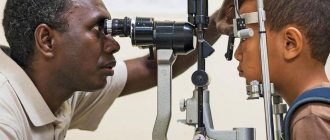Cataract is a pathology of the eye lens that leads to partial or complete loss of vision. The lens of a healthy eyeball is transparent, but disease makes it cloudy, causing light rays to refract incorrectly. Thus, an eye affected by cataracts projects a fuzzy, blurry image.
Infantile cataracts are a disease that most often occurs in newborns. However, there are cases of acquired cataracts in children under one year of age. If the affected eye is not treated, the child may go blind, because this disease is progressive. If parents contact the clinic in a timely manner, it is possible to get rid of the pathology and restore full vision.
Features of cataracts in children
Cloudiness of the lens with cataracts can be either complete or partial. The degree of the disease is determined by an ophthalmologist through examination and special tests. Even if the pathology is visually visible only on one eyeball, the specialist diagnoses both eyes.
Cataracts in children can develop and provoke the appearance of accompanying diseases:
- inflammation of the eye;
- retinal detachment;
- swelling of the eye;
- lens luxation;
- amblyopia;
- secondary cataract.
Types and degrees of disease
Based on the time of occurrence of childhood cataracts, the disease can be divided into 2 types:
- congenital - detected after examination in the first days of the baby’s life;
- acquired - diagnosed 2-3 months after birth, sometimes after the first year of life.
Depending on the location, the pathology has the following types:
- capsular - opacification extends only to the lens capsule;
- polar – affects the capsule and substance of the lens;
- layered - spreads across the center of the lens;
- nuclear - at best, it affects only the embryonic nucleus, then visual acuity decreases slightly. However, most often the disease is hereditary and vision gradually deteriorates to the point of complete blindness;
- complete - a congenital pathology, when a child is born with a completely clouded lens and reacts only to bright light;
- complicated – occurs as a result of the development of another disease. For example, diabetes, deafness, heart disease, etc.
The degree of the disease is determined by the doctor after diagnosis. The larger the damage to the lens, the worse the patient's vision. There are unilateral and bilateral cataracts. Unilateral affects one eye and is more dangerous due to the risk of amblyopia. With “lazy eye” syndrome (amblyopia), the work of one organ of vision is suppressed and the entire load goes to the second, healthy eye. Thus, the disease progresses faster, leading to irreversible vision loss.
Treatment options
After thorough examinations have been carried out and the diagnosis has been confirmed, determining the type and form of the pathology, the pediatric ophthalmologist draws up an individual treatment plan for each young patient.
Important! If the clouding does not inhibit the development of normal visual function, surgical intervention is not required, but the pathology must be constantly monitored.
Features of cataract treatment
If a decrease in central vision or an obstacle to its development is detected, surgical removal of the pathology will be required, which will allow the child’s visual ability to function and develop within normal limits.
Operation
In which cases surgical intervention is necessary, and when you can wait, the doctor decides. But if visual acuity decreases dynamically, the need for surgery arises immediately. Ophthalmological surgeons have different opinions regarding the tactics of surgery for pediatric congenital cataracts. This operation has a certain degree of risk, since a complication of the intervention is increased pressure inside the eye. This in turn makes it possible for secondary glaucoma to develop. General anesthesia, which is used for the operation, is also dangerous.
Surgery
Important! Experts believe that the optimal age for lens replacement for congenital infant cataracts is from one and a half to three months.
The most balanced operation in terms of safety and effectiveness is phacoemulsification. It is performed on children from the age of two. It is rarely done to infants. This is an effective way to save a child from the vision loss that awaits him due to dynamically developing cataracts. The lens is completely removed and replaced with an intraocular lens.
Cataract surgery - intraocular lenses
By the way. The implant is made from modern anatomical material that is biocompatible with the human body, so the patient does not experience discomfort in the postoperative period due to the invasion of a foreign body.
They operate with ultrasound or laser. With these devices, the pathological lens is liquefied and removed from the eye through a microscopic incision, which subsequently closes itself, without stitches.
By the way. For this type of operation in an adult, general anesthesia is not required, but a small child is mobile and uncontrollable, it is difficult to immobilize him, so it is necessary here.
Intraocular lens
Once the operation is completed and the anesthesia has worn off, the patient can be taken home.
There is an opinion among some experts that after liquefying and removing the lens, you should not immediately implant an implant, since the eyeball continues to grow and increase in size. But the sooner the artificial substitute is in the eye, the more correctly and within the limits of the eye vision will develop in the future. To solve this problem, artificial lenses that stretch to suit the growth of the eyeball were invented. After the intervention, optical vision correction may be necessary, which is performed after the micro-incision has healed.
Stages of introducing an artificial lens
Important! Treatment and implantation should be carried out early, since there is a high probability of developing amblyopia that cannot be further corrected.
Newborn babies undergo a lensvitrectomy on the closed eye. This surgical procedure can be performed in the first months of a child’s life, since technically the risk of retinal detachment is negligible. But in the postoperative period, the small patient needs to be monitored for a long time and carefully.
Three-month-old child with congenital cataracts
Three month old child after surgery
As for conservative methods of treating congenital cataracts, they can only be used to correct minor opacities that do not cause global visual impairment. Vitamin preparations and cytoprotectors are used for therapy.
Prevention and prognosis
Thanks to modern surgical discoveries, the postoperative prognosis is favorable. If the lens is removed and replaced in the first weeks or months (up to six), and then vision correction is performed, the child’s adaptation proceeds without problems. But congenital cataracts are rarely isolated and are not accompanied by complications. Because of this, the prognosis is not always good if it is accompanied by concomitant pathologies.
Congenital cataract. Adviсe
Preventive measures should be taken by the mother during pregnancy.
- Avoid contact with infected people.
- Teratogenic factors are minimized, among which smoking and alcohol are not the least important.
- Radiation diagnostic and therapeutic methods are excluded.
- If a pregnant woman has diabetes, she should be under the supervision of an endocrinologist for the entire period.
Diabetes and pregnancy
Important! If the pathology is of chromosomal origin, it is diagnosed before birth, and parents can decide whether to carry the pregnancy or terminate it based on the diagnostic results.
Congenital cataract is a large-scale pathology that must be detected as early as possible. Therefore, if risk factors were present at any stage of pregnancy, it is necessary to pay attention to the possibility of developing pathology during a diagnostic examination of the pregnant woman, and also immediately after the birth of the child, carry out a full ophthalmological examination.
Main causes of childhood cataracts
Congenital cataracts in children develop in utero and can occur due to the following factors:
- viral disease during the first trimester of pregnancy;
- abuse of alcohol, drugs or contraceptives during pregnancy;
- chronic illnesses of parents;
- different Rh factor in mother and child;
- lack of vitamins;
- metabolic disorders.
Premature birth can cause congenital cataracts . In premature babies, the visual system is not fully formed, which can lead to the development of cataracts and other eye diseases.
Acquired childhood cataracts occur due to the negative impact of external factors on the fragile body:
- head and eye injuries;
- bad ecology;
- illnesses of the baby (diabetes mellitus, infection, toxocariasis and others);
- taking medications that are inappropriate for children;
- impaired metabolism;
- radiation.
Depending on the cause of cataracts in children and the nature of the disease, appropriate treatment is prescribed. If you seek help from a clinic in the initial stages of pathology development, it is possible to restore the ability of the lens to focus light rays.
Symptoms
It is quite difficult for parents to identify the symptoms of cataracts in young children. You should carefully monitor the child's behavior. Signs of cataracts in newborns:
- gray/white pupils;
- the child’s eyes move quickly and do not focus on one point;
- the child does not observe what is happening around him or examines objects with one eye;
- strabismus.
In one-year-olds and older children, cataracts appear gradually. Visual acuity decreases depending on the degree of damage to the lens.
Symptoms of childhood cataracts:
- blurred vision;
- when viewing a picture or photo, a child cannot clearly answer what exactly is shown there due to blurred lines;
- in ordinary life situations, the child behaves differently, becomes more irritable, withdraws into himself;
- complaints of dots and stripes flashing before the eyes;
- the color of objects is distorted, the shades are confused.
Cataracts can cause poor development of the baby. Due to insufficient visual acuity, the child loses interest in activities that require long-term concentration. It is very difficult to learn to read and write, because straight lines seem blurry, letters blur and become like spots. To rule out vision problems in such cases, it is necessary to undergo an examination. Doctors recommend checking your child's vision at least once a year.
Complications of congenital cataracts
Complications include:
- blindness;
- amblyopia;
- strabismus;
- nystagmus;
- macular degeneration of the retina;
- pathologies of the vitreous body;
- optic nerve atrophy;
- earlier development of refractive errors and accommodation in the fellow eye (due to the increased load on it several times).
Postoperative complications include secondary glaucoma, retinal detachment, swelling of the eye structures, and implant rejection.
Diagnosis of cataracts in children
Congenital cataracts are often diagnosed during the first examination of a baby after birth. However, the pediatrician does not always detect vision problems in a child. Most often, the disease is detected when you return to the clinic for a routine examination. Also, when parents identify symptoms, they independently make an appointment for their children to see an ophthalmologist.
The ophthalmologist is primarily involved in collecting anamnesis - information that will help in making a diagnosis (information about medical history, previous diseases, etc.). After this, visual acuity is checked, the retina is examined, visual fields are identified, and the pressure inside the eyeball is measured.
Possible examinations that a child must undergo for an accurate diagnosis:
- ophthalmoscopy – assessment of the condition of the fundus using a mirror or electric ophthalmoscope;
- optical coherence tomography (OCT) – using a special device, the layers of the retina are scanned, after which the image is transmitted to the monitor;
- biomicroscopy – examination of the cornea, lens, anterior segment of the eye. The diagnosis takes place in complete darkness, the ophthalmologist directs a beam of light onto the patient’s lens and, through a microscope mounted on a special device, determines the transparency of the lens, refractive power, etc.
Older children are prescribed a visual acuity test using the Sivtsev or Orlova table. The lines of the first table contain letters, so this diagnosis is carried out for school-age children. Orlova’s table contains pictures instead of letters, which is why the table is used to test visual acuity for patients who do not yet know the alphabet.
Classification of congenital cataracts
Based on the shape and location of the turbidity, the following are distinguished:
- polar cataract;
- layered (zonular);
- handbag;
- central (nuclear);
- fusiform;
- full;
- captivated.
If one eye is involved in the pathological process, they speak of unilateral cataracts, and both eyes - bilateral. Unilateral lesions are often accompanied by microphthalmos (small eye size). In this regard, the following are highlighted:
- unilateral cataract without microphthalmos;
- with microphthalmia;
- with primary hyperplastic persistent vitreous syndrome.
This classification is important for determining the timing and methods of surgical treatment.
There are 3 degrees of the disease:
- Congenital cataract 1st degree. This is an unexpressed clouding of the optical lens, in which the doctor can examine the fundus of the eye. Visual acuity is about 0.15±0.05. Almost half of patients have binocular vision.
- Grade 2 is characterized by severe clouding, when the doctor has difficulty examining the fundus of the eye. Sharpness 0.05±0.09. Binocular vision is absent.
- 3rd degree. Total cataract. Sharpness below 0.05. Binocular vision is absent. Ophthalmoscopy and retinoscopy are not possible.
Common forms of cataracts are polar and layered. The first type is characterized by a round or oval clouding on the anterior or posterior pole of the lens. The area is located under the capsule and fused with it.
Layered, or zonular, cataracts are characterized by areas of opacification in certain layers surrounding the nucleus. In this case, transparent zones alternate with opaque ones. The degree of decrease in visual acuity depends on the density of the cloudy layers closer to the center.
Marsupial cataract is a rare disease. Characterized by clouding of the lens bag. Turbid areas of various shapes and locations.
Skolkovo talked about the possibility of complete restoration of vision
A new drug for the treatment of vision was presented at the innovation center. The medicine is not commercial and will not be advertised...
Read completely
The nuclear form is characterized by cloudy deposits in the core area.
How to treat cataracts in children
Treatment of cataracts with medications is not effective. Eye drops can only slow down the development of the disease, but not restore full vision. The only option for young patients is surgery.
Surgical intervention is carried out taking into account the following factors:
- patient's age;
- degree of cataract development;
- type of disease;
- the presence of accompanying diseases.
Cataract surgery is performed under general anesthesia. The essence of the treatment is that the affected lens is removed and a new one is put in its place, which will act as a natural lens. The artificial lens has greater optical power, which allows the child to regain full vision. The implant is replaced as the child grows.
Removing a cataract surgically takes from 15 minutes to half an hour, depending on the complexity of the case. Infants are placed in a hospital after surgery, while older children can undergo the recovery period at home.
The success of the operation also depends on the rehabilitation process. The eye heals in about two weeks. To avoid complications, you must follow your doctor’s instructions: use special eye drops to prevent infectious diseases, come regularly for examinations, and avoid getting water in your eyes for one month.
To correct vision, an ophthalmologist may also prescribe wearing glasses. This is possible with a bilateral form of the disease. Glasses can be with multifocal and bifocal lenses. The former help focus vision on objects that are close, far and at an average distance from the child. Bifocals allow you to clearly see what is far or close.
Symptoms
If congenital cataracts are poorly developed, doctors in the maternity hospital may miss the disease. It is detected at an initial appointment with an ophthalmologist, which should be made from 1 to 3 months of the baby’s life.
If the disease is severely developed, already in the maternity hospital doctors will determine the following characteristic clinical symptoms:
- cloudiness of the eyes that looks like a white discolored spot;
- possible squint;
- rarely nystagmus, that is, uncontrolled movement of the eyeballs in different directions;
- lack of concentration of gaze on various objects by 2 months;
- at an older age, the child is not oriented in space and cannot see objects.
If the disease develops in only one eye, the brain gradually turns it off from function. Therefore, instead of binocular vision, the patient develops monocular vision. This means that he sees only with one eye and cannot determine the distance to objects.
Vision can be restored without surgery
Non-surgical eye treatment in 1 month...
>
Prevention of childhood cataracts
If one of the parents (or both parents) has cataracts, then you need to inform the gynecologist about this before conceiving a child. It is necessary to undergo examinations to identify the hereditary factor of the disease. To prevent the development of cataracts in utero, the mother is prescribed special treatment and vitamins. Also, the expectant mother should:
- stop drinking alcohol and strong drugs;
- promptly treat infectious diseases if they arise during pregnancy;
- protect yourself from injury, radiation;
- spend more time outdoors;
- Healthy food;
- worry and worry less to eliminate the risk of premature birth.
To prevent acquired cataracts in children, you must adhere to the following recommendations:
- provide optimal lighting in the nursery so that the child can play and study comfortably;
- watch how we feed the child. His diet should always contain vegetables, fish, fruits, and dairy products so that the body is saturated with vitamins and minerals;
- walk more in the fresh air. Limit your time watching cartoons, playing games on a computer or tablet;
- do not forget to undergo routine examinations with an ophthalmologist every year;
- Monitor your child's hygiene. Infectious diseases associated with unwashed hands are one of the causes of eye diseases;
- Buy sunglasses for your child. This should only be done in an optician under the guidance of a specialist. Otherwise, there is a risk of buying glasses with poor quality lenses that will not protect the eyeball from ultraviolet radiation and bright light.
Diagnostic methods
It is often possible to diagnose the disease already in the second trimester of pregnancy using ultrasound. At this stage, the lens appears as a dark spot (if its development occurs normally). If it was not possible to confirm or exclude the diagnosis at this stage, repeating the diagnosis in the third trimester will insure you. Of course, no doctor will guarantee a 100% result, but pathology can be suspected with a high percentage of probability.
The next diagnosis is carried out after the birth of the baby. At first it is just a visual examination by an ophthalmologist. If there is any suspicion of existing abnormalities in the visual organ, a number of additional studies are carried out. Among them: slit biomicroscopy, ophthalmoscopy, OCT (examination of eye tissue). The eyeball is also examined using ultrasound.
Cost of cataract surgery
| Last edit: | 06.05.2019 | |
| Surgical treatment of cataracts | ||
| № | Service name | Price, UAH |
| 1 | Phacoemulsification of cataracts with implantation of HemaFold IOL (Global Ophthalmica) | 8000,00 |
| 2 | Phacoemulsification of cataracts with IOL implantation (US Optics) | 8950,00 |
| 3 | Phacoemulsification of cataracts with implantation of IOL “SL 907” (US Optics) | 9950,00 |
| Phacoemulsification of cataracts with IOL implantation" "611HPS" "/ 640AB Q-Flex | 13250,00 | |
| 4 | Phacoemulsification of cataracts with implantation of IOL “SA60AT” (Alcon) for disabled people, combatants, participants in the liquidation of the Chernobyl nuclear power plant accident upon presentation of the appropriate certificate | 13250,00 |
| Phacoemulsification of cataracts with implantation of IOL “SA60AT” (Alcon) for disabled people, combatants, participants in the liquidation of the Chernobyl nuclear power plant accident upon presentation of the appropriate certificate | 13250,00 | |
| 5 | Phacoemulsification of cataract with implantation of aspheric IOL “Clare” (Cristalens) | 15950,00 |
| 6 | Phacoemulsification of cataracts with implantation of IOL “SA60AT” (Alcon) / IOL “MA60MA” (Alcon) / IOL “MA1AC” (Alcon) with a 5% discount | 18700,00 17750,00 |
| 7 | Phacoemulsification of cataracts with implantation of the Hydro-Sense Aspheric IOL (Rumex) | 18400,00 |
| Phacoemulsification with implantation of an aspheric IOL Basis Q B2AW00 / Basis Z B1AW00 (1stQ) (Germany) | 14700,00 | |
| 8 | Phacoemulsification of cataract with implantation of aspheric IOL “SN60WF” IQ (Alcon) with a 5% discount | 22000,00 20900,00 |
| Phacoemulsification of cataracts with implantation of aspheric IOL “TECNIS Q” (Johnson & Johnson) with a 5% discount | 19250,00 16750,00 | |
| 9 | Phacoemulsification of cataracts with implantation of an aspheric IOL “Adapt AO / MI 60” (Bausch & Lomb) with a 5% discount | 23050,00 21900,00 |
| Phacoemulsification of cataracts with implantation of monofocal toric IOL “SN60T3 -T5” (Alcon) | 24300,00 | |
| 10 | Phacoemulsification of cataracts with implantation of monofocal toric IOL “SN60T6-T9” (Alcon) | 33500,00 |
| 11 | Phacoemulsification of cataracts with implantation of multifocal IOL “Lentis 313” (Oculentis) / Medicontur Liberty | 35500,00 |
| 12 | Phacoemulsification of cataracts with implantation of multifocal IOL “AcrySof IQ PanOptix” (Alcon) with a 5% discount | 47300,00 44900,00 |
| 13 | Phacoemulsification of cataracts with implantation of toric IOLs Acrysof Panoptix TFNT 20 (Alcon) USA with a 5% discount | 52650,00 49990,00 |
| Phacoemulsification of cataracts with implantation of toric IOLs Acrysof Panoptix TFNT 30 Alcon USA with a 5% discount | 56750,00 53900,00 | |
| 14 | Phacoemulsification of cataracts with implantation of toric IOLs Acrysof Panoptix TFNT 40, 50, 60. Alcon with a 5% discount | 60950,00 57900,00 |
| 15 | Additional payment for complications of cataract phacoemulsification | 2900,00 |
| 16 | Removal of secondary cataracts (surgical method) | 6900,00 |
| 17 | YAG laser dissection of secondary cataracts | 3800,00 |
| 18 | Additional payment for surgery on the lens, complicated by other diseases (infectious and post-traumatic diseases of the cornea, diabetes mellitus, glaucoma, scar changes in the eyeball, subluxation of the lens, uveitis, complications of myopia, refractive surgery) | 6900,00 |
| 19 | Suture fixation of IOL | 8900,00 |
| 20 | Phacoemulsification of cataracts with implantation of HemaFold IOL (Global Ophthalmica) | 8000,00 |
| 21 | Phacoemulsification of cataracts with IOL implantation (US Optics) | 8950,00 |
Definition of disease
Cataract is a clouding of the eye lens that leads to visual deprivation, that is, a deterioration in stimulation of the sensory system. The retinal receptors begin to work worse due to the fact that the cloudy lens does not allow light in the required volumes to reach the cones, which translate irritations from light into nerve impulses.
This disease occurs in approximately one newborn per 10,000. Moreover, the bilateral form of cataracts in children is observed more often than its unilateral counterpart.
It is customary to divide cataracts in children into those associated with hereditary anomalies and non-hereditary ones.
Causes of pathological changes
The following factors lead to the formation of congenital cataracts:
- Hereditary predisposition.
- Metabolic disorders.
- Maternal diseases that affect the intrauterine development of the fetus.
- A case of Rh-conflict between parents.
- Inflammatory processes of the visual organs in the fetus.
- Toxic effects.
- Diseases of the endocrine system in the mother.
- Toxicosis of pregnant women.
- Lack of vitamins A and E or folic acid.
Genetic abnormalities also cause pathology. However, in this case, symptoms appear later.











